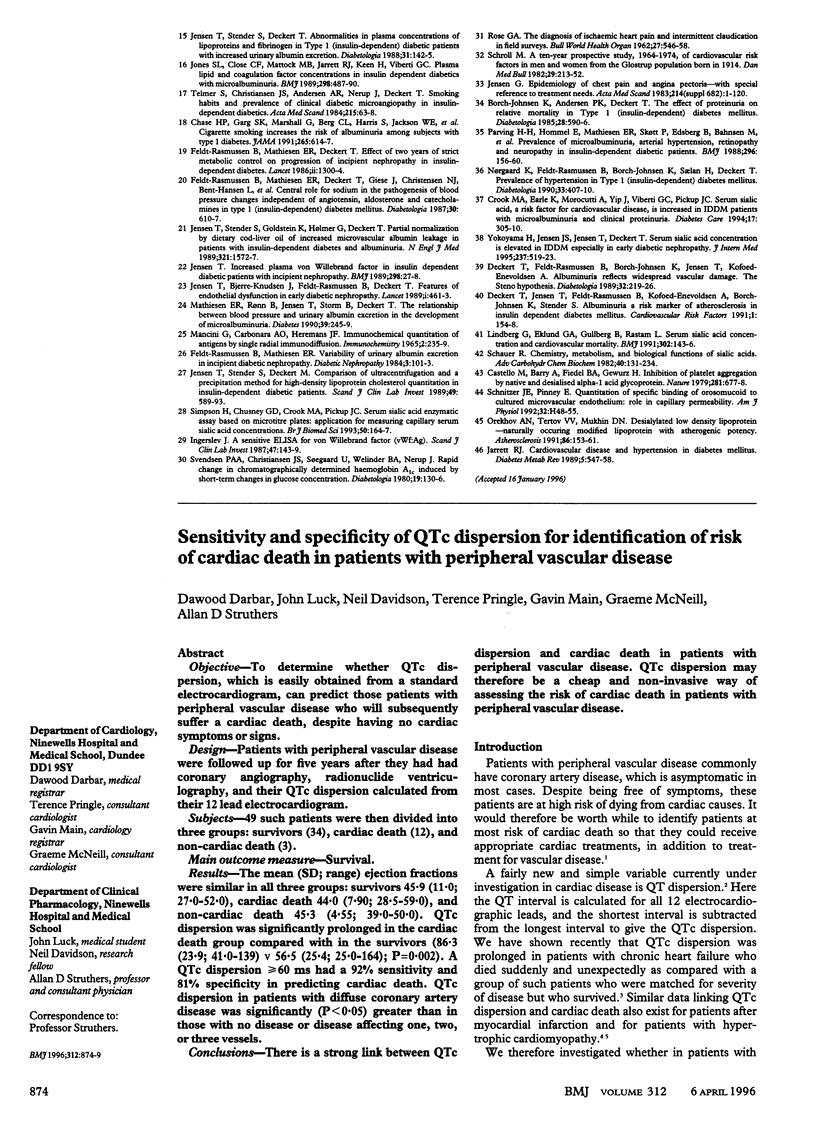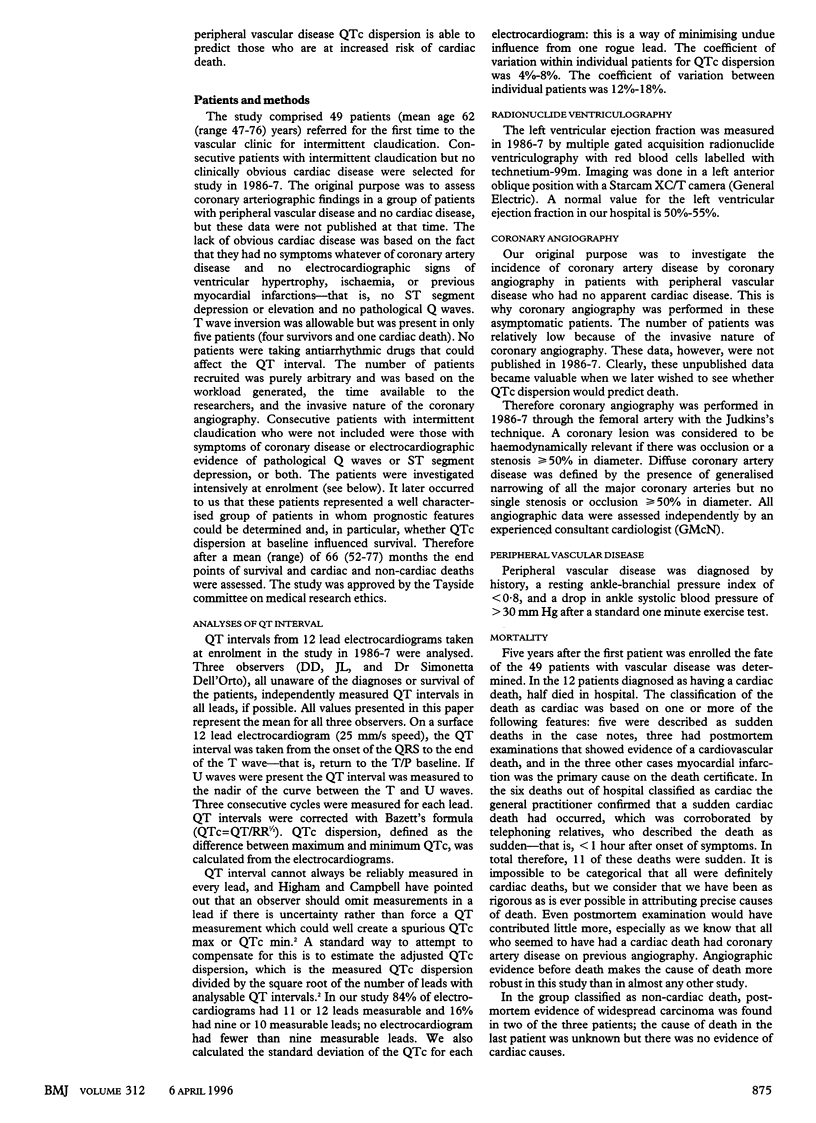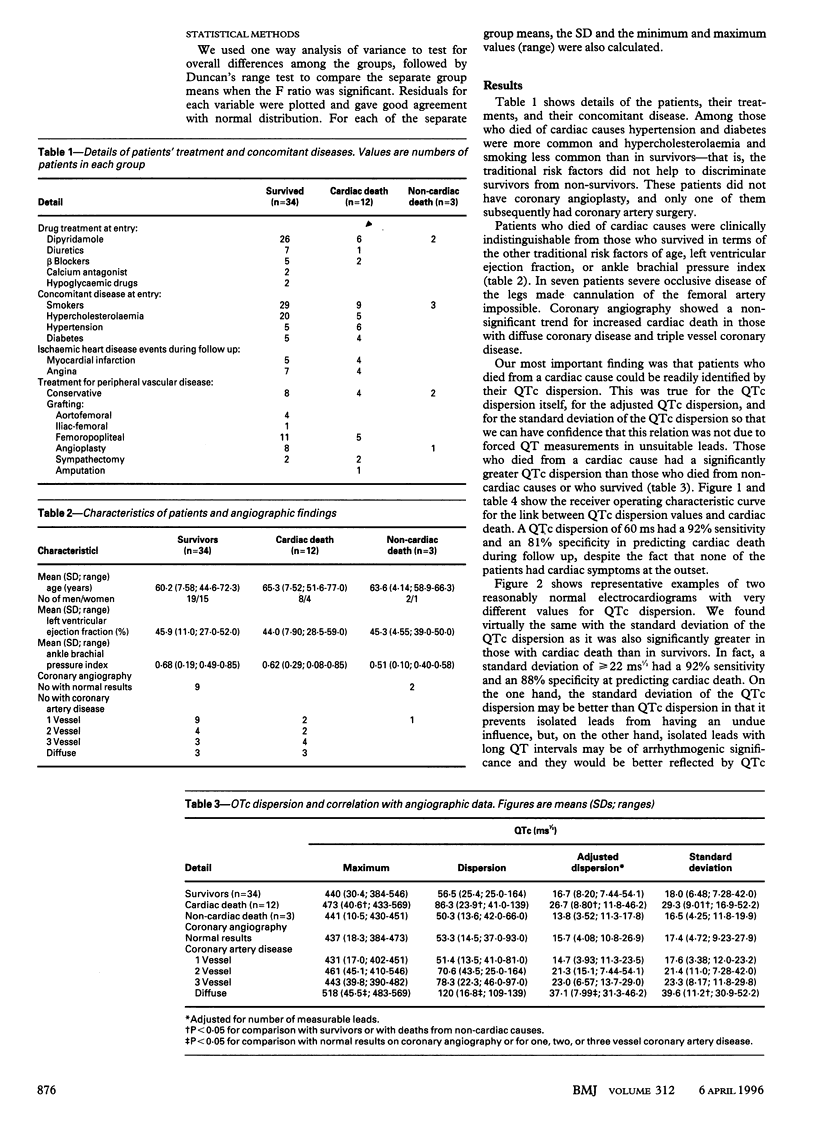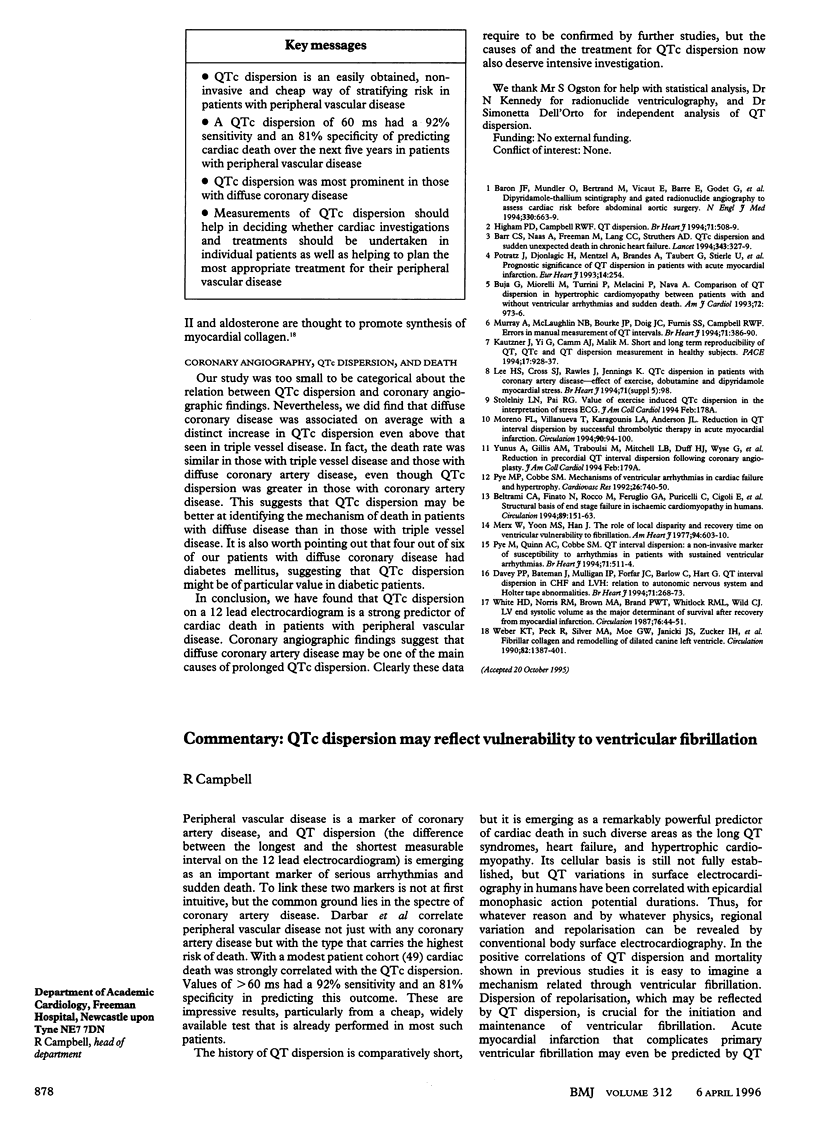Abstract
OBJECTIVE: To determine whether QTc dispersion, which is easily obtained from a standard electrocardiogram, can predict those patients with peripheral vascular disease who will subsequently suffer a cardiac death, despite having no cardiac symptoms or signs. DESIGN: Patients with peripheral vascular disease were followed up for five years after they had had coronary angiography, radionuclide ventriculography, and their QTc dispersion calculated from their 12 lead electrocardiogram. SUBJECTS: 49 such patients were then divided into three groups: survivors (34), cardiac death (12), and non-cardiac death (3). MAIN OUTCOME MEASURE: Survival. RESULTS: The mean (SD; range) ejection fractions were similar in all three groups: survivors 45.9 (11.0; 27.0-52.0), cardiac death 44.0 (7.90; 28.5-59.0), and non-cardiac death 45.3 (4.55; 39.0-50.0). QTc dispersion was significantly prolonged in the cardiac death group compared with in the survivors (86.3(23.9; 41.0-139) v 56.5 (25.4; 25.0-164); P = 0.002). A QTc dispersion > or = 60 ms had a 92% sensitivity and 81% specificity in predicting cardiac death, QTc dispersion in patients with diffuse coronary artery disease was significantly (P < 0.05) greater than in those with no disease or disease affecting one, two, or three vessels. CONCLUSIONS: There is a strong link between QTc dispersion and cardiac death in patients with peripheral vascular disease. QTc dispersion may therefore be a cheap and non-invasive way of assessing the risk of cardiac death in patients with peripheral vascular disease.
Full text
PDF




Selected References
These references are in PubMed. This may not be the complete list of references from this article.
- Baron J. F., Mundler O., Bertrand M., Vicaut E., Barré E., Godet G., Samama C. M., Coriat P., Kieffer E., Viars P. Dipyridamole-thallium scintigraphy and gated radionuclide angiography to assess cardiac risk before abdominal aortic surgery. N Engl J Med. 1994 Mar 10;330(10):663–669. doi: 10.1056/NEJM199403103301002. [DOI] [PubMed] [Google Scholar]
- Barr C. S., Naas A., Freeman M., Lang C. C., Struthers A. D. QT dispersion and sudden unexpected death in chronic heart failure. Lancet. 1994 Feb 5;343(8893):327–329. doi: 10.1016/s0140-6736(94)91164-9. [DOI] [PubMed] [Google Scholar]
- Beltrami C. A., Finato N., Rocco M., Feruglio G. A., Puricelli C., Cigola E., Quaini F., Sonnenblick E. H., Olivetti G., Anversa P. Structural basis of end-stage failure in ischemic cardiomyopathy in humans. Circulation. 1994 Jan;89(1):151–163. doi: 10.1161/01.cir.89.1.151. [DOI] [PubMed] [Google Scholar]
- Buja G., Miorelli M., Turrini P., Melacini P., Nava A. Comparison of QT dispersion in hypertrophic cardiomyopathy between patients with and without ventricular arrhythmias and sudden death. Am J Cardiol. 1993 Oct 15;72(12):973–976. doi: 10.1016/0002-9149(93)91118-2. [DOI] [PubMed] [Google Scholar]
- Davey P. P., Bateman J., Mulligan I. P., Forfar C., Barlow C., Hart G. QT interval dispersion in chronic heart failure and left ventricular hypertrophy: relation to autonomic nervous system and Holter tape abnormalities. Br Heart J. 1994 Mar;71(3):268–273. doi: 10.1136/hrt.71.3.268. [DOI] [PMC free article] [PubMed] [Google Scholar]
- Higham P. D., Campbell R. W. QT dispersion. Br Heart J. 1994 Jun;71(6):508–510. doi: 10.1136/hrt.71.6.508. [DOI] [PMC free article] [PubMed] [Google Scholar]
- Kautzner J., Yi G., Camm A. J., Malik M. Short- and long-term reproducibility of QT, QTc, and QT dispersion measurement in healthy subjects. Pacing Clin Electrophysiol. 1994 May;17(5 Pt 1):928–937. doi: 10.1111/j.1540-8159.1994.tb01435.x. [DOI] [PubMed] [Google Scholar]
- Merx W., Yoon M. S., Han J. The role of local disparity in conduction and recovery time on ventricular vulnerability to fibrillation. Am Heart J. 1977 Nov;94(5):603–610. doi: 10.1016/s0002-8703(77)80130-0. [DOI] [PubMed] [Google Scholar]
- Moreno F. L., Villanueva T., Karagounis L. A., Anderson J. L. Reduction in QT interval dispersion by successful thrombolytic therapy in acute myocardial infarction. TEAM-2 Study Investigators. Circulation. 1994 Jul;90(1):94–100. doi: 10.1161/01.cir.90.1.94. [DOI] [PubMed] [Google Scholar]
- Murray A., McLaughlin N. B., Bourke J. P., Doig J. C., Furniss S. S., Campbell R. W. Errors in manual measurement of QT intervals. Br Heart J. 1994 Apr;71(4):386–390. doi: 10.1136/hrt.71.4.386. [DOI] [PMC free article] [PubMed] [Google Scholar]
- Pye M. P., Cobbe S. M. Mechanisms of ventricular arrhythmias in cardiac failure and hypertrophy. Cardiovasc Res. 1992 Aug;26(8):740–750. doi: 10.1093/cvr/26.8.740. [DOI] [PubMed] [Google Scholar]
- Weber K. T., Pick R., Silver M. A., Moe G. W., Janicki J. S., Zucker I. H., Armstrong P. W. Fibrillar collagen and remodeling of dilated canine left ventricle. Circulation. 1990 Oct;82(4):1387–1401. doi: 10.1161/01.cir.82.4.1387. [DOI] [PubMed] [Google Scholar]
- White H. D., Norris R. M., Brown M. A., Brandt P. W., Whitlock R. M., Wild C. J. Left ventricular end-systolic volume as the major determinant of survival after recovery from myocardial infarction. Circulation. 1987 Jul;76(1):44–51. doi: 10.1161/01.cir.76.1.44. [DOI] [PubMed] [Google Scholar]


